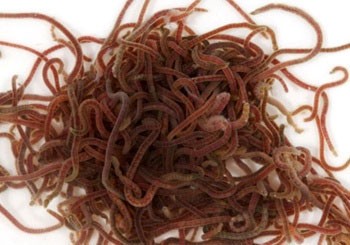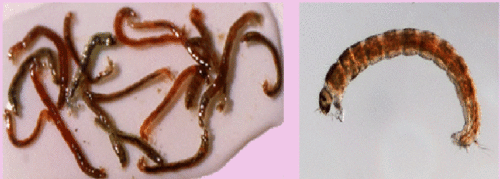Live fish foods are now very popular choice for many commercial fish breeders due to their high gradient food value. There are many important types of live foods available for use in aquaculture. For successful fish farming, you may choose the following one:
- Microbs
- Artemia
- Copepods
- Rotifers
- Earthworms
- Grindal worms
- Maggots (fly larvae)
- Microworms
- Chironomid larvae
- Tanypus larvae
- Mosquito larvae
- Vinegar eels
- White worms
- Wingless fruit flies
Microbes
Yeast can be directly used as a primary food source for many larvae,. However, it is mainly used as food for zooplankton. Yeast is grown for use in larval cultivation. It is an important ingredient in larval artificial food. It is used instead of algae as food for post larval period shrimp.
Artemia
Artemia is a type of zooplankton, known as brine shrimp. Artemia is used in fin fish and crustacean larvae in aquarium businesses such as copepodes and daphnia. More than 50 geographical species of Artemia have been identified. There are many companies that cultivate and supply the artemia throughout the world.
About 90% of the world’s commercially grown brine shrimp cysts come from the Great Lakes. Every gram cyst of normal quality yields 200,000-300,000 naupleus larvae (Treces, 2000). Artemia is widely used as a living food in aquaculture hatcheries. It is an animal closely related to shrimp which belong to the order Anostracha of the class Crustacea in the phylum Arthropoda.

The biggest advantage of using Artemia is that you can use dry and preservative powders such as dormant artemia cyst to produce live food. This cyst emerges in seawater within 24 hours and is able to regenerate metabolically as an independent swimming Napoleus larvae. The larvae tend to be about 0.4 mm in length.
It is used as live food that contains high nutritional value and high conversion rate. Artemia is used as food in all stages of life such as cyst, naupleus larvae, juvenile, pre-adult stage, etc. Artemia is now used as a single food in most commercial fish hatcheries.
Fishermen, fish breeders and Aquaculturists widely use frozen adult artemia. Artemia biomass is also used to make protein-rich foods and pharmaceutical products or to increase the quality of pet food. Even in some countries it is being used as human food. Artemia cultivation has emerged as an emerging trade in some countries of the world due to its wide utility.
In fish farming, the size of Nauplius affects the utility of Artemia. Its physical size varies from one geographical area to another. This is why the Indian native species of Artemia does not bring good results in hatcheries. In this case, fish culturits tend to rely on imported Artemia cysts.
Naupleus larvae from Moina and Artemia ensure higher growth rate and survival rate of mature guppy fish. It is easy to make food for guppy fish usinge the combination of Brachionus calyciflorus and Artemia naupleus larvae. Now it is used more practically for commercial fish breeding business to increase the fty production (Lim et al., 2003).
Copepods
These are common freshwater and brackish water zooplankton that belong to the order Copepoda of the class Crustacea. The body of the copepod is divided into head, chest and abdomen. The body is cylindrical in shape, the trunk has 10 segments. Adult copepods are 0.5-5.0 mm in size. Their larval stages have six Naupleus and Copepodite stages.
The main suborders of copepods are Calanoida (Diaptomus spp.), Herpecticoida (Brycamptus spp.) And Cyclopoida (Cyclops spp.). Herbivorous copepods are basically filter feeders and they consume very fine particle food. Copypods can also eat garbage. They do sexual intercourse after reaching maturity. Female copepods can produce 250-750 fertilized eggs. Rotifers, on the other hand, produce 15-25 fertilized eggs. The lifespan of copypods is 40-50 days whereas the lifespan of rotifers is 5-10 days.
They have been used as a natural food for many fin fish and immature fish. It is thought that Copepods may meet the nutritional needs of fish larvae (Dhaubas B.D., 2003). In nature, many fish larvae eat copepod eggs in the first few weeks of life.
The larvae of the some copipod species are considered to be an excellent food for the first feeding fish larvae due to their small size and high nutrient content. A significant number of fish larvae cannot be reared using rotifers as the first food.
Some studied on some species, such as the turbot or the red snapper, have shown that smaller larvae feed on more copepod larvae (naupleus) than rotifers. Because copepod larvae come in a variety of sizes, these fish prefer copepod naupleus larvae. As a result, the use of copepods as food sources for small larvae is increasing at a significant rate.
Tubifex
Tubifex is a type of insect belonging to the class Oligochaeta under the phylum Annelida. They are usually seen in groups in drainage system. If they deviate from their normal position, they go into the mud. Although they do not have larvae or post larvae stage, but they are used by ornamental /aquarium fish breeders as ideal food for their fish.
Among the natural live food organisms Tubifex tubifex is the best food for various fish. Because their breeding season is short, they are found in a variety of habitats and can tolerate a wide range of environmental variations (Kadhanghbat, 1980). According to Mahmut et al. (2003) it contains crude proteins, lipids, ash and moisture content of 11.02±0.58, 2.14±0.06, 1.83±0.16, and 18.78±0.83 respectively.
Total fatty acids based on dry weight are 7.28 mg/100 mg and u-3 (c18: 3n-3 and c20: 5n-3) and u-6 (c18: 2n-6c and c20: 8n-6) ) The amount of fatty acids is 16% and 22% of the total fatty acids, respectively. The richest amino acids are (amino acid / 100 g protein) lysine (6.54±0.12), leucine (6.52±0.13), arginine (5.39±0.04), valine (4.92±0.09), threonine (4.81±0.09), phenyl alanine (4.36±0.09), isoleucine (4.31±0.06), tyrosine (2.74±0.07), Histidine (2.67±0.03) and methionine (1.62±0.04). The total carotenoid level in Tubifex is 15.02±0.08 mg /kg.

Live Fish Foods: Tubifex
Culture of Tubifex
Tubifex is easily culture extensively in containers. In this case, the bottom of the container is filled with pnd mud of 50-65 mm. The pond mud contains rotten vegetables and fodder and bread are mixed. Continuous gentle water flow is maintained in the container and so that artificial drainage system is created.
After taking these measures, Tubifex worms are added to the container from the nearest canal or sewer. Tubifex worms are produced in groups within 15 days. The mud is removed and placed in a wide-mouthed plastic container. In the absence of oxygen, they move to the surface and are actually collected. They are washed by the flow of water to remove mud. As there is mud in the intestines, it is removed by adequate water flow. In this way, tubifex insects are used as fish food after proper cleaning.
Chironomid Larvae
Chironomid larvae are one of the most diverse, and ecologically important groups in aquatic macro-invertebrates (Kaufmann and Pericun, 1974). It is an animal of the class Insecta under order Diptera of the phylum Arthropoda. Because they have hemoglobin in their body fluids, hence, they are commonly called blood worms (donkey fowl, 2005).
The larvae initially live in soft tubes made of organic matter. Early mature larvae are dark red in color. These larvae have become an important food for many fish and reared invertebrates (Habib et al., 1992; Tidwell et al. 1997).These live foods are very popular in the aquarium fish business.
Chironomide larvae are an excellent source of protein, vitamins and minerals (Mclarney et al. 1974). It contains relatively high levels of protein (56%) which have high digestibility rate (Dela Moue and Choubert, 1995).
Chironomid larvae have been used as a rich food for many fish due to their biological activities in fish. They also act as growth promoters of fish and crustaceans. According to Armitage (1995), due to its high energy holding capacity, bottom animals also use chironomid larvae and pupae as food sources (4.1-6.1 kcal / g).

Image Showing Chironomid Larvae
Culture of Chironomid Larvae
This type of Benthos insect group is abundant in freshwater ecosystems. They have high fertility rate. Each mature female lays 2300 eggs at a time. The larvae grow within 16-20 days and become edible (Madlen, 2005).
Soil and compost manure or decomposed organic matter are added to the water in a flat tray to attract the Chironomidi fly to lay eggs. Sometimes adult chironomids also lay their eggs in clear closed water. They are herbivores and eat algae, rotten matter, and decayed organic matter as their diet (Habib et al., 1992).
Initially, the larvae live in soft tubes made of organic matter, which can be seen in the lower bottom regions. After 2-3 days the larvae come out of the tube and swim vertically and independently in the water. The larvae are collected by Scupnet and washed before use as food. It is used as a staple food in almost all types of carnivorous fish fry.
You might also read: Vitamin Requirements of Fish
